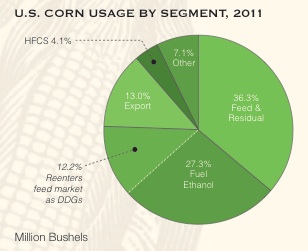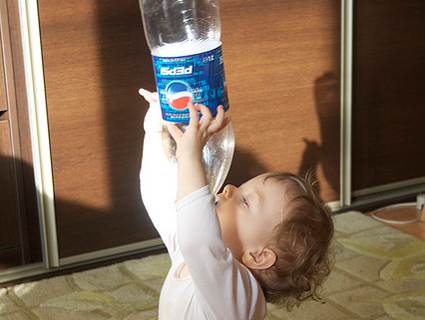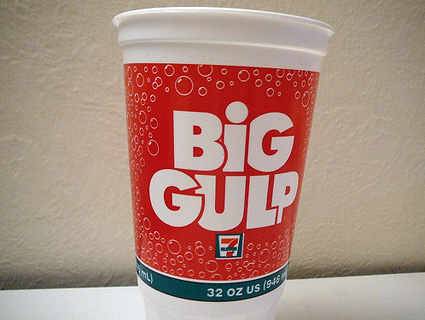
In today’s Econundrum, Maddie Oatman argues in favor of taxing soda. She points out the scary amounts of calories that people consume in the form of sweetened beverages—and the mounting evidence that sugar, like alcohol and tobacco, is addictive. Oatman speaks to an economist who has crunched the numbers and believes that a penny-per-ounce soda tax (like the one proposed in Richmond, California) could actually be enough to persuade consumers to quit their Big Gulp habits. The revenue from such a tax could also be used to pay for health care and education.
But as Oatman also points out, the idea of a soda tax is nothing if not divisive. Which means it should make for a fun debate. We’re lucky to have two experts to facilitate a conversation on the subject and answer reader questions: nutritionist and author Marion Nestle, whose new book is called Why Calories Count: From Science to Politics, and MoJo food and ag blogger Tom Philpott. Got a question for Nestle and Philpott? Leave it in the comments section, tweet it at @Econundrums, or email it to econundrums@motherjones.com. We’ll be updating this post with more questions and answers as they come in.
Jump to the latest answers from our experts:
-
Is soda really what’s making us fat, anyway?
- If we kick our soda habit, will our excess corn syrup just go to the developing world and make people fat there?
- Are there really such things as “good calories” and “bad calories”?
- Why not tax/ban OJ? Lots of “addictive sugar.”
- Why not tax ALL sugar, not just soda?
-
How much money do corn growers get in government subsidies to make the syrup that sweetens many sodas?
To get things rolling, we asked Nestle and Philpott: Is soda really what’s making us fat, anyway?
 Marion Nestle: Excess calories are what make people fat. Consuming more calories than are expended in body functions and activity. The calories can come from anywhere, but the calories from sugar sweetened beverages differ in two ways from food calories: They have no nutrients to accompany their sugars (the calories are “empty”), and they are in liquid form. We are seeing increasing evidence that the body does not regulate liquid calories as well as it regulates calories that are absorbed more slowly from foods. That’s why the Center for Science in the Public Interest calls sugary drinks “liquid candy,” and why advice saying “don’t drink your calories” makes such good sense.
Marion Nestle: Excess calories are what make people fat. Consuming more calories than are expended in body functions and activity. The calories can come from anywhere, but the calories from sugar sweetened beverages differ in two ways from food calories: They have no nutrients to accompany their sugars (the calories are “empty”), and they are in liquid form. We are seeing increasing evidence that the body does not regulate liquid calories as well as it regulates calories that are absorbed more slowly from foods. That’s why the Center for Science in the Public Interest calls sugary drinks “liquid candy,” and why advice saying “don’t drink your calories” makes such good sense.
 Tom Philpott: I agree with Marion, with a possible caveat. First, there’s strong circumstantial evidence that added sweeteners play a big role in the obesity problem. US obesity rates were pretty stable until about 1980, when they began to rise rapidly. The CDC tells us (PDF) they doubled between 1980 and 2000. Perhaps not coincidentally, per capita sweetener consumption began to rise dramatically over that same period—USDA figures tell us that we took in about 120 pounds of sweeteners per person per year in 1980, and by 1999 we were ingesting 151 pounds. That’s a 25 percent jump.
Tom Philpott: I agree with Marion, with a possible caveat. First, there’s strong circumstantial evidence that added sweeteners play a big role in the obesity problem. US obesity rates were pretty stable until about 1980, when they began to rise rapidly. The CDC tells us (PDF) they doubled between 1980 and 2000. Perhaps not coincidentally, per capita sweetener consumption began to rise dramatically over that same period—USDA figures tell us that we took in about 120 pounds of sweeteners per person per year in 1980, and by 1999 we were ingesting 151 pounds. That’s a 25 percent jump.
Driving this surge was the rise of cheap high-fructose corn syrup, used heavily by the beverage industry beginning in the early 1980s, the consumption of which went from 19 pounds annually per capita in 1980 to more than 60 pounds by 1999. Since then, under pressure from health worries, sweetener consumption has come down; the latest figures, from 2010, indicate that we’re taking in 131 pounds of total sweetener (of which 49 pounds are HFCS). Still, that’s 8 percent more total sweeteners than we consumed in 1980 (which I remember as a pretty sugar-soaked time).
And USDA figures are averages—some people avoid added sweeteners, while others are still swilling sugary soft drinks like it’s 1999. As for Marion’s empty-calories analysis, The New York Times Magazine journalist Gary Taubes has marshaled considerable evidence that isolated sweeteners—conventional sugar and HFCS alike—are not just empty calories, but are downright toxic. According to Taubes and the science he cites, these substances are metabolized in a way that gives rise to excess fat and insulin resistance. I certainly don’t have the scientific chops to evaluate Taubes, but his analysis is compelling.
What are the geopolitics associated with US corn and the beverage industry? Assuming a soda tax were passed here and people lessened their consumption, would it be more likely that the excess be shifted to overseas markets or would it, over time, help reduce demand for cheap corn inputs? -Madison W.
 Tom Philpott: Ok, a wonky question deserves a wonky answer—with a chart and number crunching! Excellent question, Madison. Short answer: some of the drop in US high-fructose corn syrup demand caused by a soda tax might be shifted overseas, but the effect will likely be limited. Here’s why.
Tom Philpott: Ok, a wonky question deserves a wonky answer—with a chart and number crunching! Excellent question, Madison. Short answer: some of the drop in US high-fructose corn syrup demand caused by a soda tax might be shifted overseas, but the effect will likely be limited. Here’s why.
As I wrote in my last post, US consumers are already consuming less HFCS—from about 60 pounds annually per capita in 1999 to 49 pounds in 2010. That’s an 18 percent drop. But according to the National Corn Growers Association’s 2012 annual corn-market report (PDF), the amount of US corn going into HFCS went from 542 million bushels in 2001 to 520 million bushels in 2010. That’s a less than 4 percent drop. So US HFCS producers are clearly churning out more product than US consumers are consuming. Where’s the excess going? This USDA document has answers.
US high-fructose corn syrup exports rose from 145,308 metric tons in 2004 to 1.28 million metric tons in 2011. In other words, HFCS exports have risen by a factor of nearly nine since 2004—a period over which our own domestic consumption of the swwet stuff was falling. The great bulk of that explosive growth can be accounted for by Mexico, whose protective tariffs against HFCS imports were dismantled in 2008 as part of NAFTA negotiations. Mexico’s imports of US HFCS went from 6,591 metric tons in 2004 to 837,845 metric tons last year—a 127-fold leap. Mexico now accounts for 65 percent of our HFCS exports. So, yes, the HFCS industry has shown it can respond to falling domestic demand by muscling into foreign markets.
However, despite its ubiquity and export power, high-fructose corn syrup only takes up 4.1 percent of the US corn crop, according to the National Corn Growers Association:

The real action for corn lies in livestock feed and ethanol. The chart tells us that 27.3 percent of corn goes to ethanol and 36.3 percent goes to feed. Then there’s the 12.2 percent that “reenters the feed market as DDGS.” That refers to dried distillers grains, which are a byproduct of ethanol production and used as livestock feed. All told, three-quarters of US corn is going to feed and ethanol. That’s a lot of corn, especially when you consider that the US corn crop accounts for 36 percent of the corn grown on planet Earth.
So say a soda tax made our HFCS consumption drop by half. I think that would be a considered a great success by the tax’s proponents. What would happen to the corn market? The HFCS industry would no doubt try to maintain production levels and send more sweetener to Mexico and other foreign markets. But I think there’s a larger force at play drawing excess US corn in another direction: east to China. There, appetite for meat is rising (PDF), policymakers are pushing a transition to industrial-scale US-style livestock production, and demand for feed corn imports is booming. The US currently exports 13 percent of its corn, and I expect that number to rise as long as China maintains growth in meat demand.
So, to answer your question, Madison, there will likely be some ongoing moderate shift in excess HFCS going to foreign markets, tempered by a growing flow of corn to China. And there is no stopping ongoing demand for cheap corn inputs.
There’s a lot of evidence that all calories are not alike when it comes to obesity and diabetes. Carbohydrates (not just sugars, but also grain-based foods such as bread, potatoes, pasta, etc.) cause our body to release insulin when they are digested. The insulin cycle triggers our body to store carbs in fat cells. When we eat meat and most other vegetables, we don’t trigger the insulin cycle, and are less likely to store fat. Soda and chips are particularly bad for us, as concerns obesity and diabetes. We need to find a way to signal this to Americans, and counter-balance the advertising of food processors. A tax is one good way to do that. -JR
 Marion Nestle: I couldn’t agree more that most people would be a lot healthier if they ate less sugar, and my co-author and I discuss the reasons for that, and why we think that the role of insulin is only part of the story of weight gain, in our book, Why Calories Count. Most studies of the effects of diets of varying composition on weight gain and loss do not control for or measure calorie intake. Instead, they rely on self-reports of calorie intake, which usually underestimate the true values. In the one study we were able to find in which investigators actually measured the calories given to hospitalized obese patients, they found no difference in the rate of weight loss when patients were given diets of widely varying protein, fat, and carbohydrate composition. We were unable to find controlled studies of the effects of varying diet composition on weight gain that measured—as opposed to estimating—calories consumed.
Marion Nestle: I couldn’t agree more that most people would be a lot healthier if they ate less sugar, and my co-author and I discuss the reasons for that, and why we think that the role of insulin is only part of the story of weight gain, in our book, Why Calories Count. Most studies of the effects of diets of varying composition on weight gain and loss do not control for or measure calorie intake. Instead, they rely on self-reports of calorie intake, which usually underestimate the true values. In the one study we were able to find in which investigators actually measured the calories given to hospitalized obese patients, they found no difference in the rate of weight loss when patients were given diets of widely varying protein, fat, and carbohydrate composition. We were unable to find controlled studies of the effects of varying diet composition on weight gain that measured—as opposed to estimating—calories consumed.
In diets that do not contain excess calories, the effects of sugars or rapidly absorbable carbohydrate on insulin levels are attenuated. Robert Lustig, for example, explains that diets that contain less than 50 grams of fructose-containing sugars a day are well tolerated by the body and do not induce excessive insulin. For people who consume 2000 calories a day, 50 grams of sugars represents about 10 percent of calorie intake (50 grams x 4 calorie per gram)—a level that public health authorities have recommended as an upper limit for decades. People gain weight because they take in more calories than they expend in basal metabolism and activity. Not overeating sugars is an excellent way to manage calorie intake. We discuss these issues and more, and explain our understanding of the science, in Why Calories Count.
Why not tax/ban OJ? Lots of “addictive sugar.” -Anthony F.
 Marion Nestle: Soft drinks are an easy target for “eat less” strategies because they contain sugars and, therefore, calories, but nothing else of nutritional value. In contrast, fruit juices contain vitamins, minerals, antioxidants, and, sometimes, fiber. Once you get past soft drinks as a target for tax strategies, you are on a nutritional slippery slope. With that said, the American Academy of Pediatrics recommends limits on juices for kids to, if I remember correctly, 12 ounces per day maximum. When I was a kid, we had special glasses for juice that contained 6 ounces. Then, Coca-Cola advertised a 16-ounce soft drink as big enough to serve 3. With all sugary drinks, the issue is portion size. No nutritionist worries about 6 or 8 ounces of any sugary drink. The bigger the drink, the more sugars it contains—and the more calories.
Marion Nestle: Soft drinks are an easy target for “eat less” strategies because they contain sugars and, therefore, calories, but nothing else of nutritional value. In contrast, fruit juices contain vitamins, minerals, antioxidants, and, sometimes, fiber. Once you get past soft drinks as a target for tax strategies, you are on a nutritional slippery slope. With that said, the American Academy of Pediatrics recommends limits on juices for kids to, if I remember correctly, 12 ounces per day maximum. When I was a kid, we had special glasses for juice that contained 6 ounces. Then, Coca-Cola advertised a 16-ounce soft drink as big enough to serve 3. With all sugary drinks, the issue is portion size. No nutritionist worries about 6 or 8 ounces of any sugary drink. The bigger the drink, the more sugars it contains—and the more calories.
I think it would make better sense to tax sugar across the board. ALL sugar, not just what’s in the many brands of soda. -Rennyrij
 Tom Philpott: Rennyrij raises a good point. Why not an added-sweetener tax at the wholesale level, instead of a retail soda tax? There’s an adage in economics that “if you want less of something, tax it.” Oatman shows that a huge portion of sweetener consumption is tied to beverages. But sweeteners are in everything—Hellman’s mayo, Skippy peanut butter, Kraft Ranch dressing, all have added sugar. In this doc (PDF) available in its web site, McDonald’s lists ingredients on dozens of menu items. The phrase “high fructose corn syrup” appears 51 times—it’s in just about every bread and sauce item the company sells, from Big Mac bun to the muffin in the Egg McMuffin to Big Mac sauce. It’s the first ingredient listed in Chipotle BBQ Sauce. Meanwhile, the word “sugar” appears in the document 226 times. Some items, including the pickle relish that goes into Big Mac sauce, has sugar and HFCS. Some have even more sweeteners. Check out the ingredients for “cilantro lime glaze,” three of the first four of which are sweeteners—in addition to the sweet blast from orange juice concentrate:
Tom Philpott: Rennyrij raises a good point. Why not an added-sweetener tax at the wholesale level, instead of a retail soda tax? There’s an adage in economics that “if you want less of something, tax it.” Oatman shows that a huge portion of sweetener consumption is tied to beverages. But sweeteners are in everything—Hellman’s mayo, Skippy peanut butter, Kraft Ranch dressing, all have added sugar. In this doc (PDF) available in its web site, McDonald’s lists ingredients on dozens of menu items. The phrase “high fructose corn syrup” appears 51 times—it’s in just about every bread and sauce item the company sells, from Big Mac bun to the muffin in the Egg McMuffin to Big Mac sauce. It’s the first ingredient listed in Chipotle BBQ Sauce. Meanwhile, the word “sugar” appears in the document 226 times. Some items, including the pickle relish that goes into Big Mac sauce, has sugar and HFCS. Some have even more sweeteners. Check out the ingredients for “cilantro lime glaze,” three of the first four of which are sweeteners—in addition to the sweet blast from orange juice concentrate:
Water, corn syrup solids, high fructose corn syrup, sugar, distilled vinegar, olive oil, soybean oil, freeze-dried orange juice concentrate, cilantro, salt, freeze-dried lime juice concentrate, xanthan gum, sodium benzoate and potassium sorbate (preservatives), garlic powder, propylene glycol alginate, spice, onion powder, citric acid
Why are companies tarting up everything from peanut butter to burger buns with caloric sweetener? Because processed sugars are a cheap way for corporations to create appealing flavors. An across-the-board added-sweetener tax would force companies to reconsider that strategy. If high enough, it could end the plague sugary-sweet items that are meant to be savory, like hamburger buns. And it would be a de facto soda tax, because soda companies would see higher costs for their soda production, which they would then pass on to consumers.
Of course, just as a sweetener tax would broader than a soda tax, opposition to it would be broader, too. It would likely include the processed food industry, sweetener-addicted fast-food companies like McDonald’s, in addition to the soda giants, the corn-refining industry, Big Sugar, etc. Those are powerful industries with plenty of cash to spend on lobbying—meaning that at the national level, the idea has zero chance of passing. But that doesn’t mean it’s a bad idea.
Could one of the authors please address the amount of tax dollars that the corn/ag industry receives in tax breaks or ‘handouts’ and how that stimulates the amount of cheaply available HFCS and other processed corn products or sweeteners? -arc64
 Marion Nestle: The Environmental Working Group has a nice summary of the amount of taxpayer dollars invested in corn subsidies. It was $3.5 billion in 2010. Subsidies make it cheaper to grow corn, encourage overproduction of corn, and permit corn to be sold more cheaply than other commodities. Overproduction stimulates development of uses for corn in feed and corn products like HFCS.
Marion Nestle: The Environmental Working Group has a nice summary of the amount of taxpayer dollars invested in corn subsidies. It was $3.5 billion in 2010. Subsidies make it cheaper to grow corn, encourage overproduction of corn, and permit corn to be sold more cheaply than other commodities. Overproduction stimulates development of uses for corn in feed and corn products like HFCS.
 Tom Philpott: Arc64, a lot of people argue that crop subsidies are the root cause of the obesity problem. Take away the subsidies, the argument goes, and high-fructose corn syrup will become expensive, and people will consume much less of it. It’s easy to see why people think this way. Until 2007, the global market was flooded with corn, prices were dirt cheap, and US farmers sold it at below the cost of production. The government paid them subsidies to make up the difference. Thus tax payers were essentially underwriting the overproduction of corn. The real winners in this game were the corn buyers, including high-fructose corn syrup makers like Archer Daniels Midland. According to Tufts researchers Tim Wise and Alice Harvie in this 2009 paper, the HFCS industry pocketed $2.2 billion in savings from access to below-cost corn between 1997 and 2005. Soda bottlers, too, benefited—to the tune of $873 million between 1997 and 2005—from access to HFCS made from corn sold at below the cost of production. Those are major taxpayer-funded windfalls to powerful industries.
Tom Philpott: Arc64, a lot of people argue that crop subsidies are the root cause of the obesity problem. Take away the subsidies, the argument goes, and high-fructose corn syrup will become expensive, and people will consume much less of it. It’s easy to see why people think this way. Until 2007, the global market was flooded with corn, prices were dirt cheap, and US farmers sold it at below the cost of production. The government paid them subsidies to make up the difference. Thus tax payers were essentially underwriting the overproduction of corn. The real winners in this game were the corn buyers, including high-fructose corn syrup makers like Archer Daniels Midland. According to Tufts researchers Tim Wise and Alice Harvie in this 2009 paper, the HFCS industry pocketed $2.2 billion in savings from access to below-cost corn between 1997 and 2005. Soda bottlers, too, benefited—to the tune of $873 million between 1997 and 2005—from access to HFCS made from corn sold at below the cost of production. Those are major taxpayer-funded windfalls to powerful industries.
But then in 2006, the price of corn began to surge. The driver was another government program—the federal ethanol mandate, signed into law by George W. Bush. New rules required gasoline mixers to add ever-increasing amounts of corn ethanol into the US gas supply. Corn prices surged, and corn subsidies fell (because some of the subsidy programs are tied to price, kicking in when prices drop below production costs). Pricier corn, lower subsidies—that should have made Big Gulps and other sweet stuff significantly more expensive, right? Trouble is, it didn’t affect prices much. Why? Wise and Harvie have an answer:
For sweetener-intensive sectors like soft drinks or baked goods, the share of sweeteners in the unit price of retail food is small, and it has fallen dramatically since 1975 as retail foods have become more highly processed. Today, HFCS represents just 3.5 percent of the total cost of soft drink manufacturing as measured by the value of shipments. Meanwhile, the corn content of HFCS represents only 1.6% of this value.
In other words, fluctuations in the price of corn just don’t have a huge impact on the final price of a Big Gulp. Companies like Coca-Cola can pay more for HFCS without having to raise consumer prices more very much.
So how do we get thee corporations to use less HFCS and other sweeteners—or make consumers think twice about buying highly sweetened products? This is where the soda tax proponents have a powerful argument. Higher corn prices don’t change the retail price of Coke much, but a soda tax can.
I should add that federal farm policy is an extremely complicated beast. Subsidies are the symptom of a policy gone bad, not the main problem in and of themselves. I teased these issues out in some length in a three-part series on farm policy back in 2007.

















